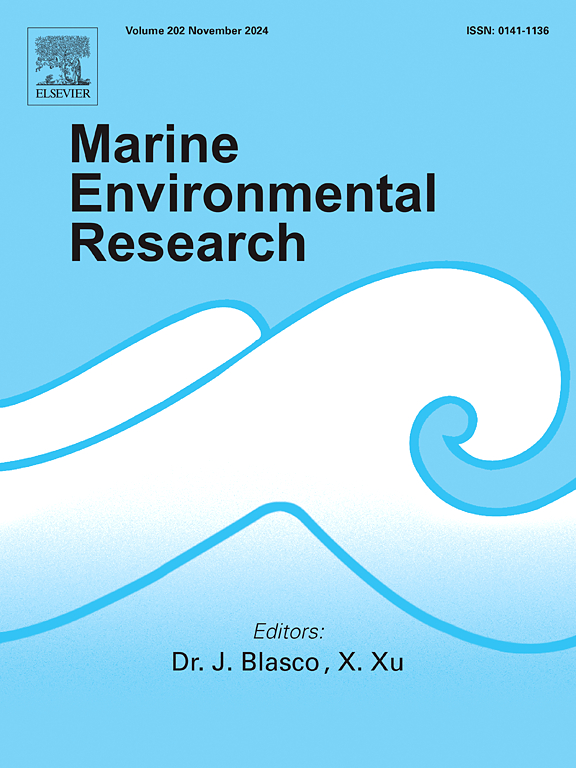Biogeochemistry of phosphorus species in water and sediments and sedimentary phosphorus release potential from a eutrophic estuary and adjacent bay
IF 3
3区 环境科学与生态学
Q2 ENVIRONMENTAL SCIENCES
引用次数: 0
Abstract
Phosphorus (P) is an essential macronutrient for sustaining primary productivity and regulating the biogeochemical cycles of key biogenic elements in estuarine ecosystems. Different P fractions in the water column and surface sediments were separated for understanding the distributions of dissolved and sedimentary P, and to evaluate the ecological risk, bioavailability and release potential of P in sediments of the Dafengjiang River Estuary (DRE) and adjacent Qinzhou Bay (QZB). The results showed that dissolved organic P was the dominant total dissolved P, which accounted for 54 ± 19 % and 60 ± 13 % in the surface and bottom seawater, respectively. Total P (TP) concentrations ranged from 6.36 to 24.13 μmol/g in the surface sediments, and predominantly consisting of inorganic P (IP). Fe bound P (Fe-P) was the dominant sedimentary IP fraction. The higher sedimentary TP concentrations and its enrichment index were observed in the DRE, implying high potential risk of eutrophication. The Langmuir crossover-type model was adopted to be suitable for the sediment sorption mechanism. The equilibrium P concentrations (EPC0) ranged from 9.23 to 18.98 μmol/L, which were significantly higher than dissolved inorganic P concentrations (0.19–1.05 μmol/L) in the overlying water, suggesting that the surface sediments acted as P source for water column. The significant positive relationship between EPC0 and exchangeable P and Fe-P contents indicated both P forms may have an important influence on the potential release of P from sediments. Native adsorbed P (NAP)/EPC0 ratio ranged from 0.06 to 0.19 L/g, and was notably elevated in the QZB, implying a high sediment adsorption capacity for P within this bay. Overall, this study provided an important perspective for better understanding biogeochemistry of P species in water and sediments and sedimentary P release potential from eutrophic estuarine and coastal ecosystem, thereby making significant contributions to future policy formulation concerning effective nutrient management strategies.

富营养化河口和邻近海湾水和沉积物中磷物种的生物地球化学及沉积物磷释放潜力
磷(P)是维持河口生态系统初级生产力和调节关键生物元素生物地球化学循环所必需的常量营养素。通过分离水体和表层沉积物中不同组分的磷,了解溶解态和沉积态磷的分布,评价大丰江口和邻近钦州湾沉积物中磷的生态风险、生物利用度和释放潜力。结果表明,溶解有机磷占总溶解磷的主导地位,在表层和底层海水中分别占54±19%和60±13%。表层沉积物中总磷(TP)含量为6.36 ~ 24.13 μmol/g,以无机磷(IP)为主。铁结合P (Fe-P)是主要的沉积IP组分。DRE沉积物TP浓度和富集指数较高,富营养化风险较高。采用Langmuir交叉模型来描述泥沙吸附机理。平衡磷浓度(EPC0)为9.23 ~ 18.98 μmol/L,显著高于上覆水体溶解无机磷浓度(0.19 ~ 1.05 μmol/L),表明表层沉积物是水柱磷源。EPC0与交换性磷和Fe-P含量呈显著正相关,表明两种形态的磷可能对沉积物中磷的潜在释放有重要影响。天然吸附P (NAP)/EPC0比值在0.06 ~ 0.19 L/g之间,且在QZB中显著升高,表明该海湾对沉积物P具有较高的吸附能力。总体而言,本研究为更好地了解水体和沉积物中磷的生物地球化学特征以及富营养化河口和沿海生态系统中沉积磷的释放潜力提供了重要视角,从而为未来制定有效的养分管理策略做出了重要贡献。
本文章由计算机程序翻译,如有差异,请以英文原文为准。
求助全文
约1分钟内获得全文
求助全文
来源期刊

Marine environmental research
环境科学-毒理学
CiteScore
5.90
自引率
3.00%
发文量
217
审稿时长
46 days
期刊介绍:
Marine Environmental Research publishes original research papers on chemical, physical, and biological interactions in the oceans and coastal waters. The journal serves as a forum for new information on biology, chemistry, and toxicology and syntheses that advance understanding of marine environmental processes.
Submission of multidisciplinary studies is encouraged. Studies that utilize experimental approaches to clarify the roles of anthropogenic and natural causes of changes in marine ecosystems are especially welcome, as are those studies that represent new developments of a theoretical or conceptual aspect of marine science. All papers published in this journal are reviewed by qualified peers prior to acceptance and publication. Examples of topics considered to be appropriate for the journal include, but are not limited to, the following:
– The extent, persistence, and consequences of change and the recovery from such change in natural marine systems
– The biochemical, physiological, and ecological consequences of contaminants to marine organisms and ecosystems
– The biogeochemistry of naturally occurring and anthropogenic substances
– Models that describe and predict the above processes
– Monitoring studies, to the extent that their results provide new information on functional processes
– Methodological papers describing improved quantitative techniques for the marine sciences.
 求助内容:
求助内容: 应助结果提醒方式:
应助结果提醒方式:


